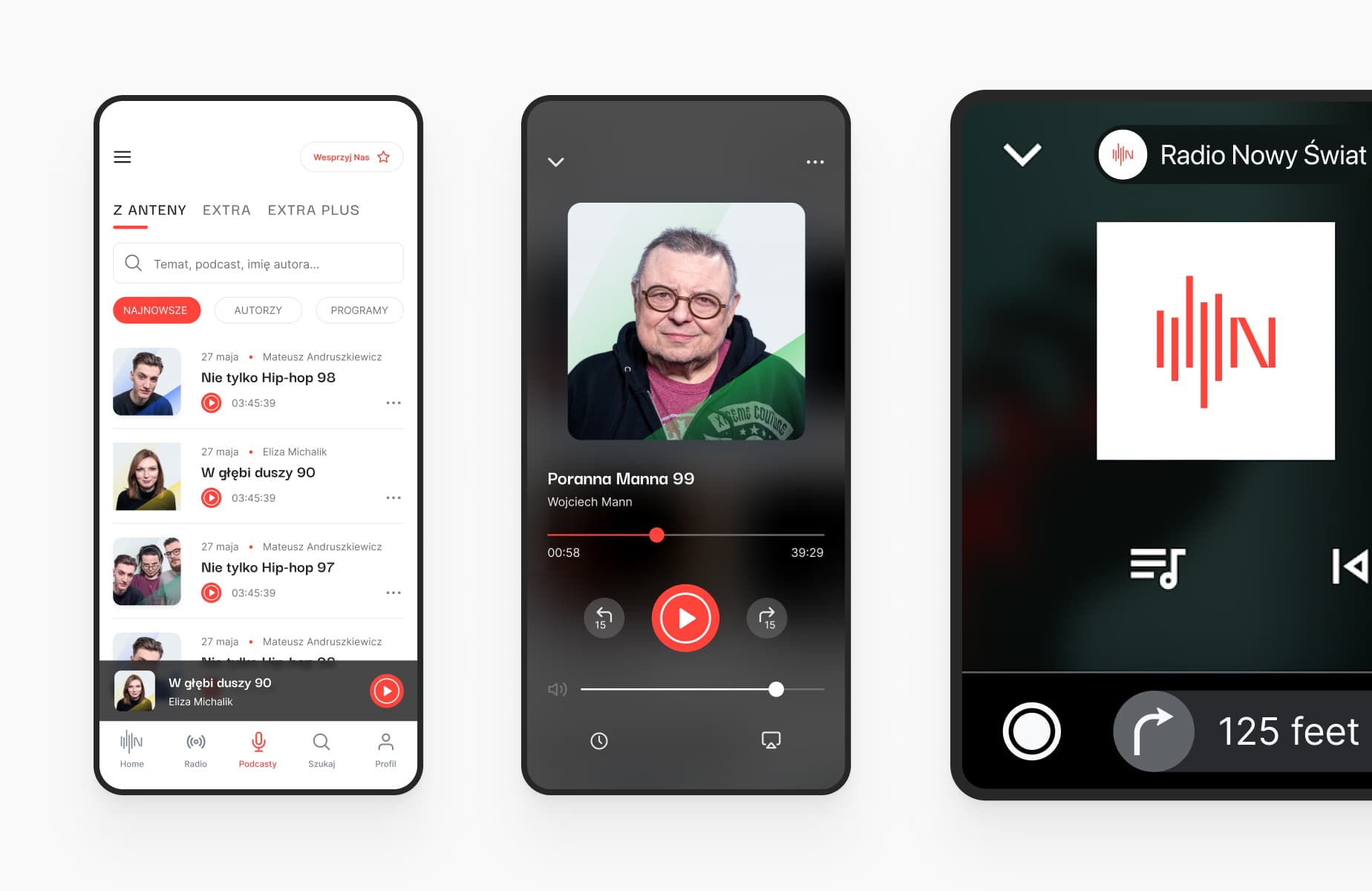Radio. The word alone brings to mind images of kitchen countertops, dashboard dials, and the comforting hum of voices that have kept us company for generations. But the form of radio has changed. Today, a mobile application has become the new standard for stations that want to stay connected with their audience. And if you think a mobile radio app is just a streaming button, you’re missing the revolution happening in the market. In this article, we’ll take a look at Radio Nowy Świat, a leading radio station in Poland, Europe—with over 200,000 daily listeners—that lives by the motto: “Listeners listen to the radio. The radio listens to the listeners.” And more importantly, this approach is paying off.
Radio Nowy Świat (RNŚ; English: “new world radio”) has proven that the radio is still a vibrant place where people look for information and discover new horizons. With its mobile radio app, RNŚ gives its listeners much more than “play” and “stop” functions.
Led by RNŚ’s example, let’s look at what functions are worth including in a modern radio app:
1. Stream quality and stream timer.
The streaming button is just the beginning. What’s important is HOW you can control streaming.
Stream Quality:
In an era of constant mobility, listeners tune in from a variety of places—on public transportation, during a jog, or even while traveling abroad.
What do all these scenarios have in common?
Variable internet quality.
That’s where stream quality control becomes indispensable. RNŚ’s mobile app gives users the ability to manually select the stream bitrate that works best for their current connection: lower quality for slower or limited data plans, and higher fidelity when Wi-Fi is strong or when audiophiles want to hear every nuance of a live concert or talk show. This simple, user-controlled feature ensures that the station is always accessible—without buffering, dropouts, or unexpected data consumption.
Stream Timer:
Whether you’re tuning in before bed, during a break, or as part of a daily routine, the ability to set a timer for the stream adds flexibility and comfort. Listeners can fall asleep to their favorite voices, knowing the app will automatically stop after a set period, conserving battery and avoiding data overuse.
2. Control on the car dashboard: Android Auto and Apple CarPlay are a must in a mobile radio app
Radio and driving have always gone hand in hand. Turning the ignition meant also tuning into the day’s news, music, or commentary. According to a survey carried out in the UK, France, and Germany, radio is a must-have for drivers; 78% of them said they wouldn’t buy a car without radio. A survey done in France (2024) states that radio accounts for 77% of all in-car audio listening among people, regardless of their age.
Radio also remains the most common audio source used in the car in the United States. Based on Nielsen Media Research, 88% of American adults listen to the radio, averaging 12.2 hours each week, or about 104 minutes per day. Most of this listening happens while people are commuting.
RNŚ understands this need by integrating its app with Android Auto and Apple CarPlay.
Listeners no longer need to fumble with their phones or risk distractions while driving. Instead, they get a safe, intuitive, and deeply familiar experience, blending the ease of touchscreens and steering wheel controls with the spontaneity and richness of live radio.
3. Podcasts… and related functions: likes, subscriptions, queuing, history, offline function, and measurement.
Today’s listeners, especially younger ones, want to control what they hear and when they hear it. Podcasts allow users to catch up on shows, explore new topics, and listen at their own pace, rather than being tied to a live schedule. This flexibility attracts new users and keeps existing ones engaged.
How did RNŚ do it? They offer:
- The ability to “like” a certain podcast or episode. Thanks to this, the user can easily go back to their favourite content.
- Subscription to new podcast episodes and authors. The user will be informed about a new episode by means of push notifications.
- Queuing is another sought after function. Listeners can line up multiple podcast episodes from different shows, allowing them to enjoy uninterrupted playback without having to manually select the next episode each time one ends. This is especially helpful when driving, exercising, or working, letting users focus on what they’re doing instead of fiddling with their phone and to avoid being distracted.
- Podcast history. For long-running shows or serialized podcasts, podcast history helps listeners remember which episodes they’ve finished and which ones are next, so users can easily re-listen to them, not accidentally repeat or skip anything.
- Downloading a podcast for offline use. Podcasts are saved to the user’s device. The user is able to see downloaded materials, listen to them offline or remove them from the downloaded list. This is especially useful when traveling, commuting through areas with poor signal, or simply to avoid using mobile data.
What’s also important is measuring the reach of your radio’s content. Your radio needs to listen to its listeners too. Knowing which podcasts are most popular, when listeners tune in, and where they drop off helps stations refine their content. On the other hand, as a radio manager, you need to think about advertisers. They want proof of audience size, engagement, and demographics before investing. Podcast measurement offers concrete data (downloads, listens, completion rates, etc.) that radio stations can use to attract sponsors and justify higher ad rates.
Mobitouch collaborated closely with RNŚ to translate their vision into a user-friendly app. Want to create a mobile app for your radio station? Let’s talk!
Book a meeting4. Functions reserved for premium users who want to co-create the radio
RNŚ stands out for its commitment to building strong, two-way relationships with its Patrons (its paid subscribers) who help fund and shape the station. RNŚ has created the “Strefa Patrona” (Patron Zone), a dedicated space designed specifically for these supporters, offering them exclusive content and opportunities to actively participate in the station’s development.
Surveys
One of the most notable features is the “Surveys: You Decide” section. This tool was developed out of a desire to foster genuine dialogue and collaboration with Patrons. Through regular surveys, RNŚ consults its Patrons on important topics and programming decisions, allowing them to co-create the radio station’s direction. The results of these surveys are not only used internally but are sometimes shared on-air, with hosts presenting poll outcomes during their shows, making listeners feel directly involved in the station’s content and evolution.
Voting for Ranking Lists
Premium users of RNŚ actively participate in voting for ranking lists.
For example, the station’s music chart-listeners, including Patrons, can vote for their favorite tracks every week through a dedicated voting page on the station’s website. Voting is open from Saturday evening to Friday evening, and the results are then presented on air.
Additionally, Patrons have opportunities to co-create other rankings, such as book and film lists, often in collaboration with station reviewers.
Special Events and Meetings
The Meetings section is for Patrons who give higher levels of support. Here, RNŚ announces and recaps special outings and exclusive meetings with editors and hosts, such as cinema trips, exhibition visits, and live events with station personalities.
Gifts and promo codes
RNŚ regularly partners with cultural institutions, artists, and event organizers to provide Patrons with promo codes, discounts, and vouchers. These can include reduced-price tickets to concerts, exhibitions, or special events, as well as discounts on merchandise or partner services. For example, in early 2025, Patrons received a 20% discount code for an Elif Sanchez live concert.
5. Spotify: an ally, not a competitor of your mobile radio app
The RNŚ mobile app includes a feature that lets users check the current playlist and, with a direct Spotify integration, transfer the songs played on RNŚ to their personal Spotify account. This means if you hear a track you like on air, you can quickly add it to your Spotify library or playlist with just a tap, and more importantly, this does not interrupt your streaming.
Additionally, RNŚ maintains a strong presence on Spotify, as well as other channels. But it is the radio station’s mobile app that offers the widest range of possibilities.
The takeaway
Radio’s reach is still enormous, but the demands and habits of listeners are evolving fast. One thing is certain: people will always love listening to music, exploring new rhythms and diving into new subjects and stories. That’s a given. What changes is the form – how, where, and when they do it. The hunger for discovery isn’t going anywhere, but the tools and expectations around it are constantly evolving. To stay up to date with their listeners, radio stations need to meet users where they are, with the features they actually want. The content quality of your radio station is the first step, the next is the form in which you offer it to the modern user. And if you do it right, your radio’s reach can become truly limitless.






